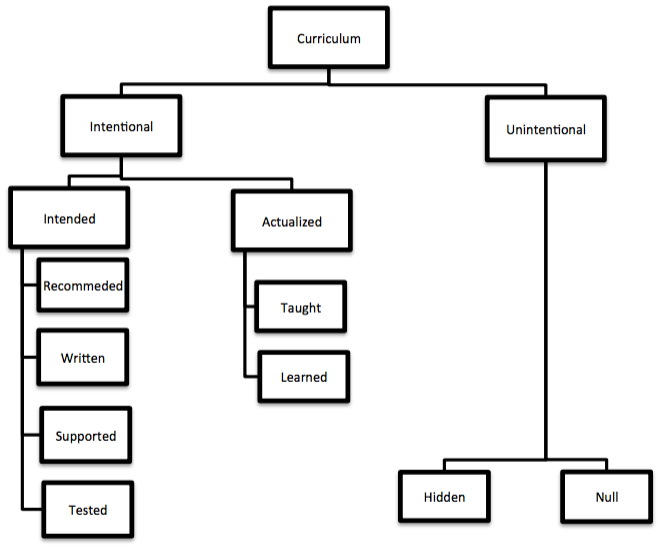The Null Curriculum is that which is not taught. Sometimes the teacher ignores some content or skill, deliberately or unknowingly. A teacher may consider some idea unimportant and ignore it. Similarly, teacher may avoid detailed description of some topic for the one or other reason, for example, evolution in Biology. Sometimes also, the learner fails to learn certain knowledge, skills or attitude for various reasons.
Gordon (1957) was first to identify that a part of the Learned Curriculum was due to unintended results of activities or efforts of the institutions. This is called the hidden curriculum. It is unintentional because the teachers as well as other members of the educational institution convey messages that are not part of the officially approved curriculum. For example, the behaviour and attitude of the teachers may affect the students. Moreover, it may also be the unintentional consequence of some act.
The curriculum that is reflected by the assessment or evaluation of the learners is called the Assessed Curriculum. It includes both formative and summative evaluation of learners conducted by teachers, schools, or external organizations. It involves all the tests (teacher- made, district or standardized) in all formats (such as portfolio, performance, production, demonstration, etc.). The assessed curriculum is significant as it enables the stakeholders to evaluate the impact of Written and Taught curricula upon the learners. It determines the level of the Learned Curriculum.
All the changes occurred in the learners due to their school experience are called the Learned Curriculum. It is the curriculum that a learner absorbs or makes sense of as a result of interaction with the teacher, class-fellows or the institution. It includes the knowledge, attitudes and skills acquired by the student. Many educationists have defined curriculum as everything the learner experiences. This emphasizes the dominance of the learner in the curriculum and excludes all that which has no effect on the learner. Thus, only the learned curriculum becomes the curriculum.
The curriculum that is delivered by the teachers to the students is termed as Taught Curriculum. Teachers, being the chief implementers of curriculum, occupy a crucial role in curriculum decision making. Taking the students into consideration, they decide how to achieve the intended learning outcomes. They decide the distribution of time to a particular activity/content. Even the external pressures like external exams cannot limit their freedom to exercise their own philosophy of instruction.
The Supported Curriculum is the curriculum supported by available resources. Such resources include both human (teachers) as well as physical (such as textbooks, workbooks, audio visual aids, teacher guides, grounds, buildings, library books and laboratory equipment). The Supported Curriculum not only plays a vital role in developing, implementing, and evaluating the curriculum, it also affects the quantity and nature of the learnt content (Glatthron, Boschee, & Whitehead, 2006, pp. 10-14).
The Written Curriculum is the curriculum that is sanctioned and approved for classroom delivery. It represents society’s needs and interests. It translates the broad goals of the “Recommended Curriculum” into specific learning outcomes. Glatthron, Boschee, and Whitehead (2006, p. 9) note that the “Written Curriculum” is specific as well as comprehensive and it indicates:
The Recommended Curriculum is the name given to the curriculum construed by the educational stakeholders at the national level. It is more general and usually consists of policy guidelines. It actually reflects the impact of “opinion shapers” such as:
The diversity in curriculum definition also continues to exist in describing its types. Different writers have used different terminology and categories of curriculum. However, it is interesting that many curriculum specialists have used different terminology for the same type of curriculum. Figure1 gives an outline of different types of curriculum.

Figure 1: Types of curriculum
Pages
